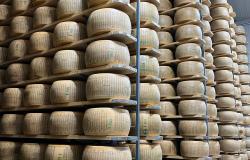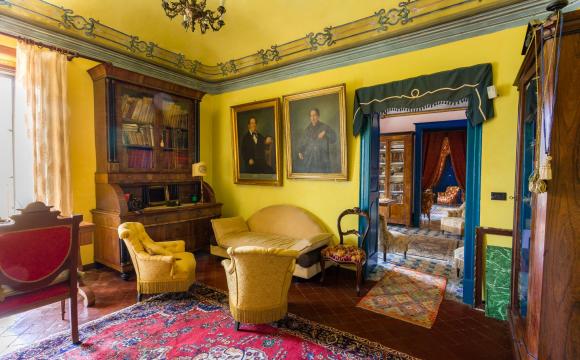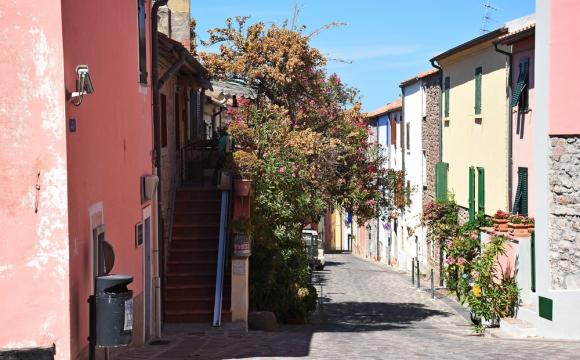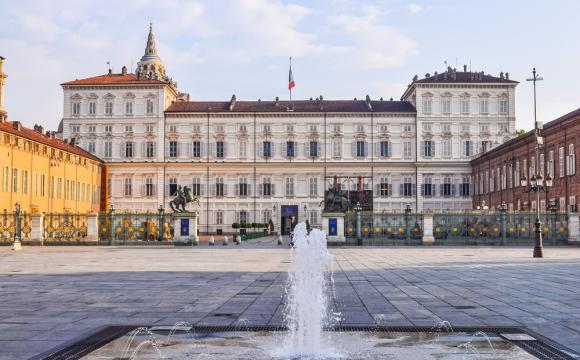Modern and fresh, elegant and graceful, this attic apartment in the seaside town on Italy’s Adriatic coast radiates pure, sleek style and that inimitable Italian touch of unabashed beauty. Roberto Semprini is one of Italy’s leading modern furniture designers and architects, and we visit the house he decorated with her wife Raffaella in their native hometown of Rimini.
The house breathes with the plentiful light from the large windows and many skylights. Totalling 200 square metres and just a few blocks from the sea, this is a contemporary house that manages to give a clear voice to its interior, its objects and its space, rather as does an elegant art museum.
 The furnishings are very few, and very restrained, and demand to be seen in their three-dimensional entirety. The fireplace built into a wall of the main room just behind the entrance hallway forms the centre stage of the room, acting like a focus or fulcrum of the sofas and the space circulating between them in the open plan design.
The furnishings are very few, and very restrained, and demand to be seen in their three-dimensional entirety. The fireplace built into a wall of the main room just behind the entrance hallway forms the centre stage of the room, acting like a focus or fulcrum of the sofas and the space circulating between them in the open plan design.
The fireplace is carefully placed within the curved wall with surgical precision and flanked by the two rectangular sections of wall which frame the entire geometrical arrangement, almost like theatrical scenic wings. This theatrical theme is further enhanced by the billowing white curtains covering the tall windows all along the opposite side of the room.
‘A careful observer will not fail to see that this is a stylized synthesis of a face’, Semprini reveals, ‘complete with a mouth and eyes’. Apart from playful if coincidental anthropomorphisms, Semprini is particularly taken by fluid forms and sensual lines, and his designs are often inspired – sometimes directly – by the female body. This is clearly evident in the gentle curves of the ‘Paolina’ sofa, which is languorously ‘reclining’ in front of the fireplace, alongside the ‘Cioccolata’ (chocolate) single sofa.
Hidden attractions
 On the side walls hang two stylised flower ‘cupboard paintings’, works of the artist Giovanni Lombardi. These are in fact paintings on hinged panels which can be opened to reveal hidden shelves for storage – an important asset in minimalist houses – and help to keep out of sight cupboards and other items which are useful but which would detract from the carefully composed, quintessential rigour of the interior design.
On the side walls hang two stylised flower ‘cupboard paintings’, works of the artist Giovanni Lombardi. These are in fact paintings on hinged panels which can be opened to reveal hidden shelves for storage – an important asset in minimalist houses – and help to keep out of sight cupboards and other items which are useful but which would detract from the carefully composed, quintessential rigour of the interior design.
Inside one of these ‘paintings’ is a mini-bar replete with local Emilian wines, grappa, whisky (bizarrely no Italian would have grappa to offer without also having whisky) and a selection of digestivi all of which are always served with the wealth of great delights of the Emilia-Romagna region – the famous cheeses, the salami and prosciutto, to mention just a few.
This same philosophy exists in the other rooms of the house where only the essential minimum of furnishings is present, each selected with great style and taste, but blended also with a playful sense of surprise and irreverence.
Temple of light
 The bedroom is a kingdom in itself – a temple dedicated to peace and tranquillity and the pursuit of relaxed, spiritual contemplation. The light which floods into the room from the many skylights defines the multi-faceted architectural spaces within the interior, dividing it up into different areas.
The bedroom is a kingdom in itself – a temple dedicated to peace and tranquillity and the pursuit of relaxed, spiritual contemplation. The light which floods into the room from the many skylights defines the multi-faceted architectural spaces within the interior, dividing it up into different areas.
Where the bed is placed, the light is softer and more conducive to repose, whereas a cone of direct sunlight illuminates the freestanding stone bath, a private haven of pure healthy living, yet still completely connected to the rest of the room as well as the rest of the world through the large skylight window above.
Next to the bath, as if to accommodate a casual observer, is the ‘Hydra’ chair, also designed by Semprini, made from coloured plastic wound around a metal frame.
Also in this room, with a hint of satirical irony, is the heavy church candle-holder. ‘I am happy to see a modern design finding a natural harmony and balance with an ancient object’, the young designer states; here, as elsewhere, can clearly be seen the basis of his style – great elegance formed by an equilibrium between these two otherwise contradictory, opposing elements. But always without resorting to excess, and with always a healthy touch of irreverence and humour.







